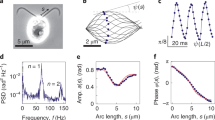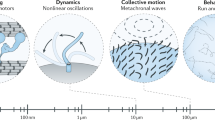Abstract
THE locomotion of ciliate protozoa is effected by cilia which modify the direction and frequency of their cyclic beating in response to sensory input from the environment1,2. In Paramecium and Stylonychia mechanical stimulation of the anterior end of the cell induces a Ca2+-dependent depolarising receptor potential which triggers a regenerative Ca2+ response3,4. Ca2+ accumulating in the ciliary space activates the axonemal motor system5 so that the normal (posterior) direction of the ciliary power stroke is reversed and the frequency is augmented6. Posterior mechanical stimulation of the cell elicits a K+-dependent hyperpolarising receptor potential followed by augmentation of ciliary frequency without reversal4,7, a mechanism which is less well understood8. Because shifts in voltage are associated with loops of electric currents across the membrane, we have examined the crucial signals transmitted from the mechanoreceptive regions to the cilia. We report here that these signals are potentials of either polarity. This is the first report of intracellularly recorded receptor currents.
This is a preview of subscription content, access via your institution
Access options
Subscribe to this journal
Receive 51 print issues and online access
$199.00 per year
only $3.90 per issue
Buy this article
- Purchase on Springer Link
- Instant access to full article PDF
Prices may be subject to local taxes which are calculated during checkout
Similar content being viewed by others
References
Eckert, R. Science 176, 473–481 (1972).
Machemer, H. & de Peyer, J. Verh. dt. zool. Ges. 1977, 86–110 (1977).
Eckert, R., Naitoh, Y. & Friedman, K. J. exp. Biol. 56, 683–694 (1972).
De Peyer, J. & Machemer, H. J. comp. Physiol. (in the press).
Naitoh, Y. & Kaneko, H. Science 176, 523–524 (1972).
Machemer, H. J. comp. Physiol. 92, 293–316 (1974).
Naitoh, Y. & Eckert, R. J. exp. Biol. 59, 53–67 (1973).
Machemer, H. Fortschr. Zool 24, 195–210 (1977).
Machemer, H. Arch. Protistenk. 108, 153–190 (1965).
De Peyer, J. & Machemer, H. J. comp. Physiol. 121, 15–32 (1977).
Dunlap, K. J. Physiol., Lond., 271, 119–133 (1977).
Dunlap, K. & Eckert, R. J. Cell Biol. 70, 245a (1976).
Ogura, A. & Takahashi, K. Nature 264, 170–172 (1976).
Hildebrand, E. Verh. dt. zool. Ges. 1976, 243 (1976).
Naitoh, Y. Zool. Mag., Tokyo 85, 367 (1976).
Takahashi, M. & Naitoh, Y. Nature 271, 656–659 (1978).
Author information
Authors and Affiliations
Rights and permissions
About this article
Cite this article
PEYER, J., MACHEMER, H. Are receptor-activated ciliary motor responses mediated through voltage or current?. Nature 276, 285–287 (1978). https://doi.org/10.1038/276285a0
Received:
Accepted:
Issue Date:
DOI: https://doi.org/10.1038/276285a0
This article is cited by
-
Breakup and then makeup: a predictive model of how cilia self-regulate hardness for posture control
Scientific Reports (2013)
-
Mechanical and electric correlates of mechanoreceptor activation of the ciliated tail inParamecium
Journal of Comparative Physiology A (1984)
-
Threshold activation and dynamic response range of cilia following low rates of membrane polarization under voltage-clamp
Journal of comparative physiology (1983)
-
Mechanoreception and signal transmission in the lateral ciliated cells on the gill ofMytilus
Journal of Comparative Physiology ? A (1982)
-
Voltage and time characteristics of the potassium mechanoreceptor current in the ciliateStylonychia
Journal of Comparative Physiology ? A (1981)
Comments
By submitting a comment you agree to abide by our Terms and Community Guidelines. If you find something abusive or that does not comply with our terms or guidelines please flag it as inappropriate.



